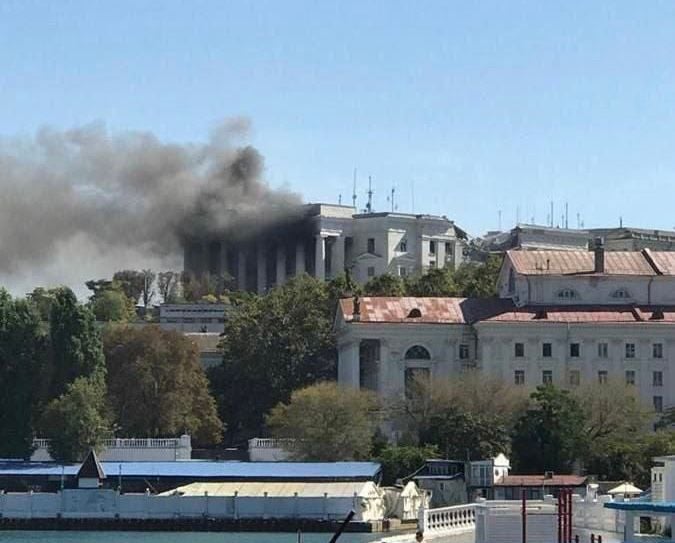Russia is ramping up the involvement of naval aviation of the Black Sea Fleet to oversee and conduct operations within the Black Sea, according to the UK’s Ministry of Defence (MOD).
First F-16 Block 70 Fighter Will Soon Be Shipped To Europe; Slovakia Set To Take Delivery Of Lockheed Jets
In its most recent intelligence update on October 2, the UK Defense Ministry noted that the Naval Aviation segment of Russia’s Black Sea Fleet has taken on a notably important role in the Fleet’s operations.
This development comes as the fleet faces challenges from multiple threats along the southern front of the Ukraine conflict.
Additionally, the UK Defense Ministry’s report indicated that the Naval Aviation unit is strongly emphasizing maritime air patrol operations, most likely with a primary focus on early detection of unmanned surface vessels.
An essential asset employed by Russia in these operations is the Be-12 MAIL amphibious aircraft, which operates from bases in Crimea.
Latest Defence Intelligence update on the situation in Ukraine – 02 October 2023.
Find out more about Defence Intelligence's use of language: https://t.co/YlymMMKcGU
🇺🇦 #StandWithUkraine 🇺🇦 pic.twitter.com/a7EK91MKZd
— Ministry of Defence 🇬🇧 (@DefenceHQ) October 2, 2023
The BE-12 MAIL is a Soviet-era turboprop-powered amphibious aircraft with its roots dating back to the 1950s. Its original design was tailored for anti-submarine warfare and maritime patrol duties.
These aircraft have had a persistent presence in Crimea, and a few months after Russia’s invasion of Ukraine began in February 2022, they were observed operating over the Crimean coast in August 2022.
The BE-12 aircraft’s reconnaissance capabilities remain valuable, as its radar can offer a foundational situational understanding of the coastline.
Meanwhile, at the same time, Su-24 and Su-27 fighter jets, known by their NATO codenames FENCER and FLANKER, respectively, are also actively involved in conducting strike operations.
A recent airstrike, for instance, targeted the strategically significant Zmiinyi (Snake) Island, highlighting the ongoing aerial actions in the region.
The Ministry also noted that Russia is taking proactive measures to address potential threats to Sevastopol by strategically relocating a substantial portion of its fleet activities to Novorossiysk.
This preemptive move aims to enhance operational security and readiness amidst the escalating tensions in the region.

In this strategic realignment, Russia prioritizes using naval air power as a pivotal tool to project force and assert influence, particularly in the north-western Black Sea.
This development arises following a sequence of assaults by Ukraine on Russia’s Black Sea Fleet. The British Defense Ministry reported on September 26 that the Russian Black Sea Fleet might experience a reduced ability to maintain its previous dominance over the Black Sea waters and could also face heightened safety concerns within its ports due to recent effective strikes by Ukrainian forces.
Ukraine’s Actions Targeting Russia’s Black Sea Fleet
Ukraine has escalated its offensive by intensifying long-range attacks into Crimea and the Black Sea, aiming to disrupt the Kremlin’s war effort by targeting critical assets far behind the front lines.
Crimea is a crucial location for stockpiling essential wartime supplies channeling them to the battlefronts in southern Ukraine. Furthermore, it houses the primary base, at Sevastopol, of the Russian Black Sea Fleet, which enforces a blockade on Ukrainian ports.
In recent weeks, Kyiv has effectively employed precision missile attacks on critical targets, including the fleet’s headquarters, and orchestrated sea drone assaults on warships stationed within ports.
These coordinated attacks have resulted in the destruction and damage of multiple vessels, causing casualties and disrupting Russian naval logistics and operations.
Notably, to compensate for its limited naval capacities, Ukraine has leveraged uncrewed surface vessels (USVs), commonly known as sea drones, to undermine the operations of the Black Sea Fleet.
The leadership in Kyiv prioritized spearheading the development of “the world’s first naval fleet of drones.”

Furthermore, in conjunction with the threat posed by sea drones, Ukraine’s military has utilized its arsenal of long-range Western-made cruise missiles, such as the UK-provided Storm Shadow, to target critical assets of the Black Sea Fleet in Sevastopol, located on the southwestern edge of the occupied Crimean peninsula.
The Ukrainians are learning to adapt to a maritime theater and significantly impact the Black Sea Fleet without a fleet.
On the other hand, experts have raised concerns regarding Russia’s lack of caution in safeguarding high-value targets like ships and military aircraft.
Moscow has exhibited a delayed response in comprehending the evolving challenge to its force deployment in Crimea and its implications for sustaining a functional fleet at sea.
Moreover, the Kremlin seems to have miscalculated Ukraine’s ability to execute impactful strikes on critical targets of the Black Sea Fleet.
However, in light of a new report suggesting Russia’s intensified involvement in Naval aviation, it appears to be an essential step Moscow took to safeguard its high-value assets from Ukrainian attacks. Yet the true extent of its effectiveness in altering the situation remains uncertain.
- Contact the author at ashishmichel(at)gmail.com
- Follow EurAsian Times on Google News




